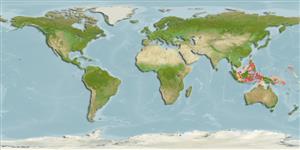Teleostei (teleosts) >
Eupercaria/misc (Various families in series Eupercaria) >
Labridae (Wrasses)
Etymology: Paracheilinus: Greek, para = the side of + Greek, chaite = hair + Greek, odous = teeth (Ref. 45335).
Environment: milieu / climate zone / depth range / distribution range
Ecology
Marine; reef-associated; depth range 6 - 20 m (Ref. 90102). Tropical
Western Central Pacific: Indonesia.
Size / Weight / Age
Maturity: Lm ? range ? - ? cm
Max length : 7.0 cm TL male/unsexed; (Ref. 48636)
Short description
Identification keys | Morphology | Morphometrics
Paracheilinus cyaneus is similar to P. nursalim, but differs most notably in having a magenta or reddish ground colour compared to the predominately orange colour of P. nursalim; in having a yellowish brown triangular marking on the spinous dorsal fin, red dorsal and ventral margins on the caudal fin which extend onto the filamentous lobes, and possession of a blue band below the eye that is about twice the width of that present in P. nursalim; lacks the pair of prominent blackish patches present in P. nursalim below the anterior dorsal fin and ventral half of the caudal peduncle. In P. nursalim either one or both of the filamentous caudal-fin lobes are generally longer than those of P. yaneus, reaching about 50% of the standard length in some individuals. P. cyaneus has a strong turquoise hue over the head, adjacent anterior body, and along the back, extending onto the dorsal fin during the climax of courtship display (Ref. 74967).
Body shape (shape guide): fusiform / normal.
Found in sheltered reefs with mixed low corals and algae-rubble (Ref. 48636). Occurs in small groups of mix sexes but females outnumber males greatly (Ref. 90102).
Life cycle and mating behavior
Maturity | Reproduction | Spawning | Eggs | Fecundity | Larvae
Oviparous, distinct pairing during breeding (Ref. 205).
Parenti, P. and J.E. Randall, 2000. An annotated checklist of the species of the labroid fish families Labridae and Scaridae. Ichthyol. Bull. J.L.B. Smith Inst. Ichthyol. (68):1-97. (Ref. 35918)
IUCN Red List Status (Ref. 130435: Version 2025-1)
Threat to humans
Harmless
Human uses
Tools
Special reports
Download XML
Internet sources
Estimates based on models
Preferred temperature (Ref.
123201): 28.8 - 29.2, mean 29 °C (based on 124 cells).
Phylogenetic diversity index (Ref.
82804): PD
50 = 0.5000 [Uniqueness, from 0.5 = low to 2.0 = high].
Bayesian length-weight: a=0.00977 (0.00470 - 0.02030), b=3.07 (2.90 - 3.24), in cm total length, based on LWR estimates for this (Sub)family-body shape (Ref.
93245).
Trophic level (Ref.
69278): 3.4 ±0.4 se; based on size and trophs of closest relatives
Resilience (Ref.
120179): High, minimum population doubling time less than 15 months (Preliminary K or Fecundity.).
Fishing Vulnerability (Ref.
59153): Low vulnerability (10 of 100).
🛈
Nutrients (Ref.
124155): Calcium = 160 [92, 351] mg/100g; Iron = 1.14 [0.63, 2.21] mg/100g; Protein = 18.2 [15.3, 20.4] %; Omega3 = 0.168 [0.090, 0.303] g/100g; Selenium = 20.6 [10.7, 42.1] μg/100g; VitaminA = 255 [75, 962] μg/100g; Zinc = 2.17 [1.37, 3.46] mg/100g (wet weight);
